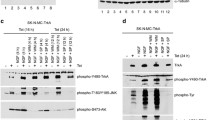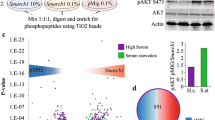Abstract
The nuclear matrix-intermediate filament system of human neuroblastoma SK-N-SH cells before and after retinoic acid (RA) treatment was selectively extracted and the distribution of prohibitin (PHB) in the nuclear matrix, as well as its colocalization with related genes, was observed. Results of two-dimensional gel electrophoresis (2-DE), mass spectrometry (MS) identification, and protein immunoblotting all confirm that PHB was present in the components of SK-N-SH nuclear matrix proteins and was down-regulated after RA treatment. Immunofluorescence microscopy observations show that PHB was localized in the nuclear matrix and its distribution was altered due to RA treatment. Laser confocal microscopy results reveal that PHB colocalized with the expression products of c-myc, c-fos, p53, and Rb, but the colocalization region was altered after RA treatment. Our results prove that PHB is a nuclear matrix protein and is localized in nuclear matrix fibers. The distribution of PHB in SK-N-SH cells and its colocalization with related proto-oncogenes and tumor suppressor genes suggest that PHB plays pivotal roles in the differentiation of SK-N-SH cells and deserves further study.




Similar content being viewed by others
References
Choi D, Lee SJ, Hong S, Kim IH, Kang S (2008) Prohibitin interacts with RNF2 and regulates E2F1 function via dual pathways. Oncogene 27:1716–1725
Dixit VD, Sridaran R, Edmonsond MA, Taub D, Thompson WE (2003) Gonadotropin-releasing hormone attenuates pregnancy-associated thymic involution and modulates the expression of antiproliferative gene product prohibitin. Endocrinology 144:1496–1505
Feng W, Webb P, Nguyen P, Liu X, Li J, Karin M, Kushner PJ (2001) Potentiation of estrogen receptor activation function 1 (AF-1) by Src/JNK through a serine 118-independent pathway. Mol Endocrinol 15:32–45
Fusaro G, Dasgupta P, Rastogi S, Joshi B, Chellappan S (2003) Prohibitin induces the transcriptional activity of p53 and is exported from the nucleus upon apoptotic signaling. J Biol Chem 278:47853–47861
Hussain-Hakimjee EA, Peng X, Mehta RR, Mehta RG (2006) Growth inhibition of carcinogen-transformed MCF-12F breast epithelial cells and hormone-sensitive BT-474 breast cancer cells by 1alpha-hydroxyvitamin D5. Carcinogenesis 27:551–559
Jang JS, Cho HY, Lee YJ, Ha WS, Kim HW (2004) The differential proteome profile of stomach cancer: identification of the biomarker candidates. Oncol Res 14:491–499
Kolonin MG, Saha PK, Chan L, Pasqualini R, Arap W (2004) Reversal of obesity by targeted ablation of adipose tissue. Nat Med 10:625–632
Li QF (1999) Effect of retinoic acid on the changes of nuclear matrix in termediate filament system in gastric carcinoma cells. World J Gastroenterol 5:417–420
Li H, Wang BC, Xu WJ, Lin XM, Peng XX (2008a) Identification and network of outer membrane proteins regulating streptomycin resistance in Escherichia coli. J Proteome Res 7:4040–4049
Li QF, Shi SL, Liu QR, Tang J, Song J, Liang Y (2008b) Anticancer effects of ginsenoside Rg1, cinnamic acid, and tanshinone IIA in osteosarcoma MG-63 cells: nuclear matrix downregulation and cytoplasmic trafficking of nucleophosmin. Int J Biochem Cell Biol 40:1918–1929
Li QF, Tang J, Liu QR, Shi SL, Chen XF, Song JY (2008c) Expression and localization of nucleophosmin during HMBA-induced differentiation in human hepatocarcinoma SMMC-7721 cells. Chin J Biochem Mol Biol 24:172–179
Li QF, Zhao CH, Tang J, Liu QR, Shi SL (2008d) Localization of prohibitin in nuclear matrix and its expressive alteration during the differentiation of human osteosarcoma MG-63 cells induced by HMBA. Fen Zi Xi Bao Sheng Wu Xue Bao 41:1–10
Lin XM, Li H, Wang C, Peng XX (2008) Proteomic analysis of nalidixic acid resistance in Escherichia coli: identification and functional characterization of OM proteins. J Proteome Res 7:2399–2405
Mishra S, Murphy LC, Nyomba BL, Murphy LJ (2005) Prohibitin: a potential target for new therapeutics. Trends Mol Med 11:192–197
Nijtmans LGJ, Sanz MA, Grivell LA, Coates PJ (2002) The mitochondrial PHB complex: roles in mitochondrial respiratory complex assembly, ageing and degenerative disease. Cell Mol Life Sci 59:143–155
Qi Y, Chiu JF, Wang L, Kwong DL, He QY (2005) Comparative proteomic analysis of esophageal squamous cell carcinoma. Proteomics 5:2960–2971
Ren HZ, Wang JS, Pan GQ, Lv H, Wen JF, Luo GQ, Wang KS, Zhang PF (2009) Comparative proteomic analysis of beta-catenin-mediated malignant progression of esophageal squamous cell carcinoma. Dis Esophagus 23(2):175–184
Sharma A, Qadri A (2004) Vi polysaccharide of Salmonella typhi targets the prohibitin family of molecules in intestinal epithelial cells and suppresses early inflammatory responses. Proc Natl Acad Sci USA 101:17492–17497
Shi SL, Li QF, Liu QR, Xu DH, Tang J, Liang Y, Zhao ZL, Yang LM (2009) Nuclear matrix protein, prohibitin, was down-regulated and translocated from nucleus to cytoplasm during the differentiation of osteosarcoma MG-63 cells induced by ginsenoside Rg1, cinnamic acid, and tanshinone IIA (RCT). J Cell Biochem 108:926–934
Sun L, Liu L, Yang XJ, Wu Z (2004) Akt binds prohibitin 2 and relieves its repression of MyoD and muscle differentiation. J Cell Sci 117:3021–3029
Tsai HW, Chow NH, Lin CP, Chan SH, Chou CY, Ho CL (2006) The significance of prohibitin and c-Met/hepatocyte growth factor receptor in the progression of cervical adenocarcinoma. Hum Pathol 37:198–204
Wang S, Nath N, Adlam M, Chellappan S (1999) Prohibitin, a potential tumor suppressor, interacts with RB and regulates E2F function. Oncogene 18:3501–3510
Wang S, Fusaro G, Padmanabhan J, Chellappan SP (2002) Prohibitin co-localizes with Rb in the nucleus and recruits N-CoR and HDAC1 for transcriptional repression. Oncogene 21:8388–8396
Xu DH, Tang J, Li QF, Shi SL, Chen XF, Liang Y (2008) Positional and expressive alteration of prohibitin during the induced differentiation of human hepatocarcinoma SMMC-7721 cells. World J Gastroenterol 14:5008–5014
Zhao CH, Li QF (2005) Altered profiles of nuclear matrix proteins during the differentiation of human gastric mucous adenocarcinoma MGc80–3 cells. World J Gastroenterol 11:4628–4633
Acknowledgments
This study was sponsored by National Natural Science Foundation of China (Grant No. 30871241).
Author information
Authors and Affiliations
Corresponding author
Rights and permissions
About this article
Cite this article
Li, QF., Liang, Y., Shi, SL. et al. Localization of Prohibitin in the Nuclear Matrix and Alteration of Its Expression During Differentiation of Human Neuroblastoma SK-N-SH Cells Induced by Retinoic Acid. Cell Mol Neurobiol 31, 203–211 (2011). https://doi.org/10.1007/s10571-010-9608-7
Received:
Accepted:
Published:
Issue Date:
DOI: https://doi.org/10.1007/s10571-010-9608-7




